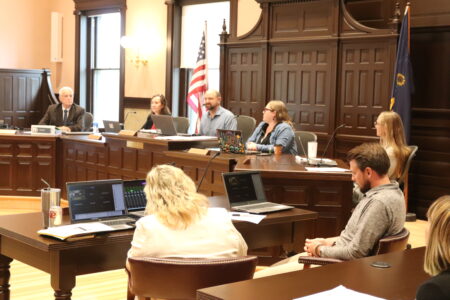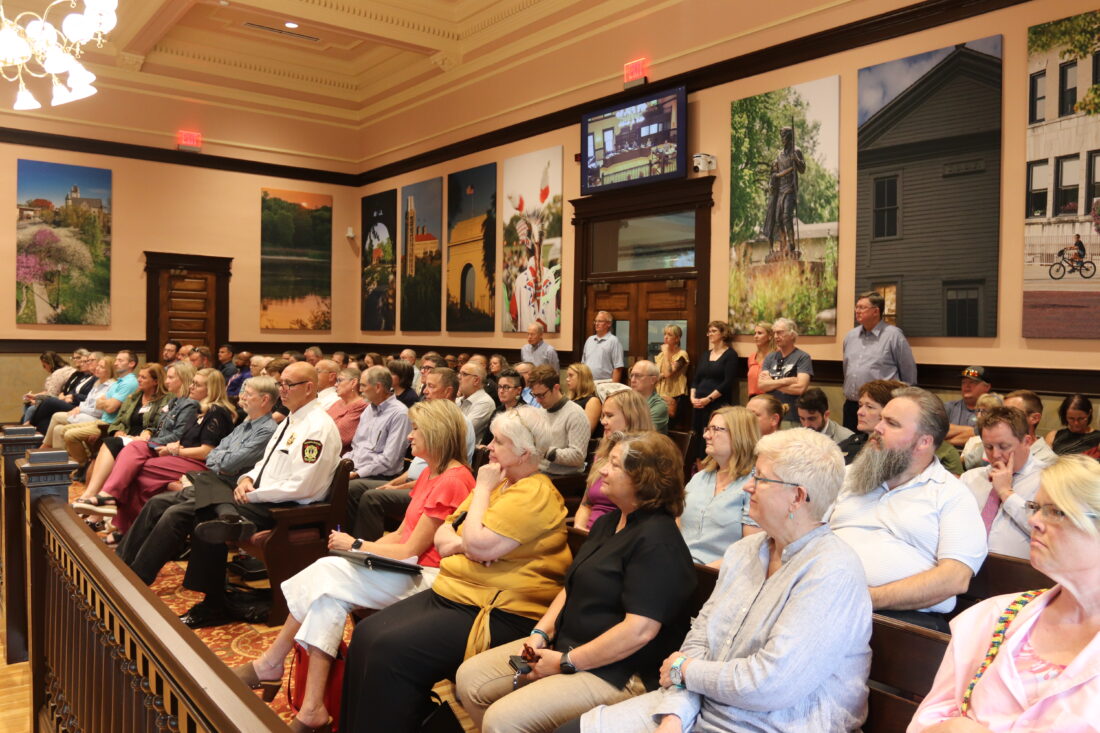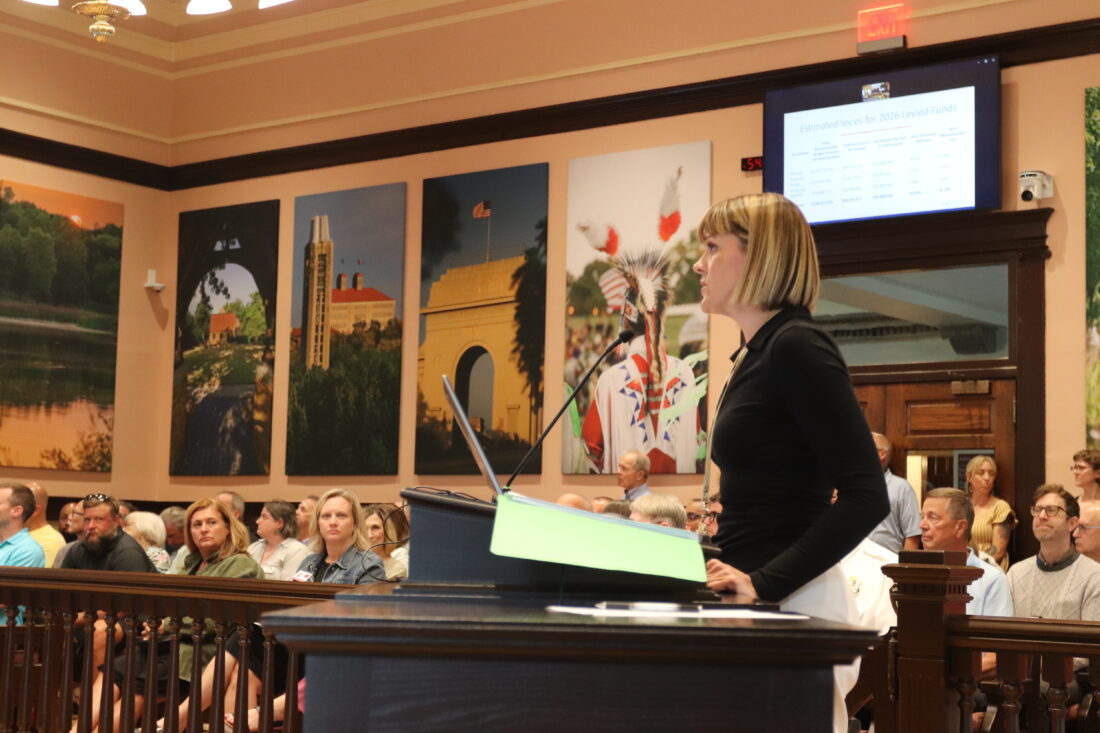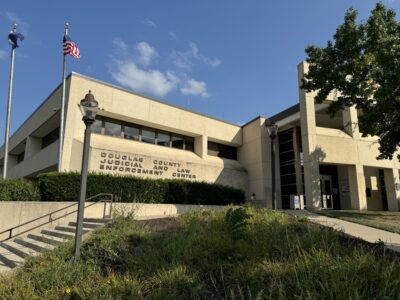Douglas County commissioners approve budget for 2026 with lower property tax rate than 2025’s

photo by: Josie Heimsoth/Journal-World
Douglas County commissioners met on Wednesday, August 27, 2025.
Douglas County commissioners approved a 2026 budget on Wednesday with a slightly lower property tax rate than the previous year’s, but an increase in the county’s total assessed property values means it still will be collecting more in property tax than it did last year.
During their weekly meeting on Wednesday, county commissioners conducted a public hearing on the budget before unanimously approving it. The property tax rate – or mill levy – will be at 40.669 mills, a decrease of 0.629 mills from the previous year, which was 41.298 mills. One mill is equal to $1 per $1,000 of a property’s assessed value.
A memo to county commissioners said that the maximum amount the county could spend in next year’s operating budget is $184 million. However, this figure includes reserve funds that may not be used, so it doesn’t reflect the actual planned spending. In 2026, the county is projected to collect $89.8 million in property tax revenue. By comparison, last year commissioners approved a $194 million spending cap and collected $86.4 million in property taxes.
Commissioner Erica Anderson said that during the budget process, which has lasted the past several months, commissioners came together and had good discussions.
“I think there were times that we may have disagreed on what we wanted to fund, but we were really able to come together and share our opinions and our viewpoints as to why we wanted to fund what we wanted to fund, what was really important to us when it came to the county as a whole,” Anderson said.

photo by: Josie Heimsoth/Journal-World
Several community organization leaders attended the public hearing for Douglas County’s 2026 budget on Wednesday, August 27, 2025.
Several leaders of nonprofit agencies attended Wednesday’s meeting, including Lori McSorley, executive director of Van Go, who thanked the commissioners for their continued support of more than 40 community partner organizations. She emphasized the important role these partners play in addressing complex issues that impact the community.
“We tackle complicated issues like mental health, food insecurity, access to health care and employment, to name a few,” McSorley said. “I hope our community understands the difficulty that is wrapped in your decisions and appreciates your dedication and commitment to those who are less fortunate in our community.”
The mill levy is only one part of the equation that produces county residents’ property tax bills. The other part is determined by the assessed value of someone’s property. With the mill levy set at 40.669 mills, a homeowner with a $600,000 property would owe $2,806 in county property taxes. For a $300,000 home, the tax bill would be $1,403, while a $200,000 home would owe $935 in taxes.
If the assessed valuation of a property goes up, people may still be paying more even if the property tax rate decreases. The total assessed property valuation in Douglas County increased by 5.7% in 2025, compared to 6.8% in the previous year.
The mill levy commissioners approved on Wednesday exceeds the “revenue neutral rate” — or the rate needed to generate the same amount of property tax revenue as the previous year, based on current assessed property values. The revenue neutral rate is 38.958 mills, which is 1.71 mills lower than the rate commissioners approved.
Unlike the vote to approve the budget itself, the vote to exceed the revenue neutral rate was not unanimous. It was 4-1, with Commissioner Gene Dorsey opposed. In explaining his vote, Dorsey said he thought the county had “underestimated some of our other incomes.” For example, he said, sales taxes could generate significantly more revenue next year if Lawrence is chosen as a FIFA World Cup base camp and with the new conference center at the University of Kansas boosting income.
Commissioner Karen Willey said this input “might have been more helpful math within the 20 hours when we were discussing the budget line by line,” referring to the week of budget hearings the commission held in July.
“Maybe we do, maybe we don’t get a base camp for the World Cup,” Willey said. “Maybe that does or doesn’t increase revenue for that, but it would be far enough in the future that I am more comfortable in doing that as a re-estimate halfway through the year than taking wild guesses outside of what the staff brings to us.”
In July, the County Commission took a vote to notify the county clerk of its intent to exceed the revenue neutral rate, and that vote was unanimous.

photo by: Josie Heimsoth/Journal-World
Brooke Sauer, finance manager at Douglas County, presents on the 2026 budget prior to the public hearing on Wednesday, August 27, 2025.
On Wednesday, the County Commission also unanimously approved a budget for Consolidated Fire District No. 1. The budget totals approximately $2.5 million and includes a half-mill increase, bringing the district’s total mill levy to 6 mills. The fire district, which serves a 228-square-mile area in Douglas County, requested additional funds to hire more personnel, address rising maintenance expenses, and strengthen its financial reserves. The approved mill levy exceeds the 2026 revenue neutral rate of 5.190 mills, and that was also unanimously approved on Wednesday.
In other business, county commissioners:
* Approved an $80,255 reimbursement request from HeadQuarters Kansas for 2023 crisis line services. Funding was previously paused in the second quarter of 2023 after county staff raised questions about how call center staff was being deployed and how the invoices reflected actual staff costs versus budgeted FTEs. Later, the county withheld payment as HeadQuarters experienced more significant leadership, management and governance issues.
County staff has since reviewed supporting documents and confirmed the request aligns with the 2023 agreement. Douglas County has no service agreements with the organization for 2024 or 2025, and no funding requests from the organization were allocated in the 2026 budget.






